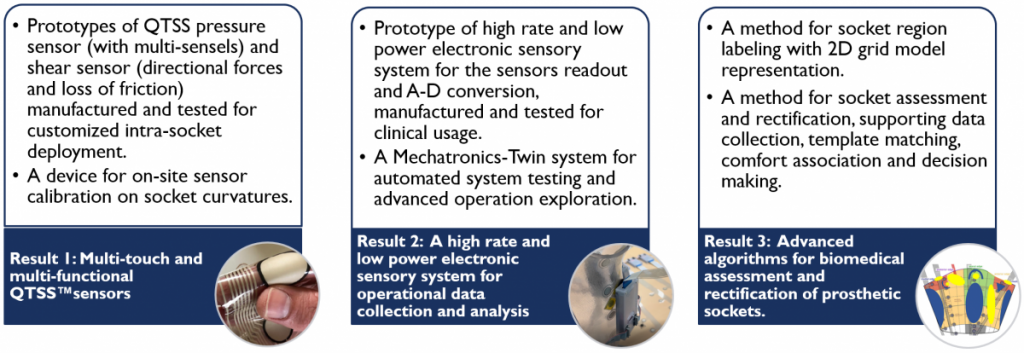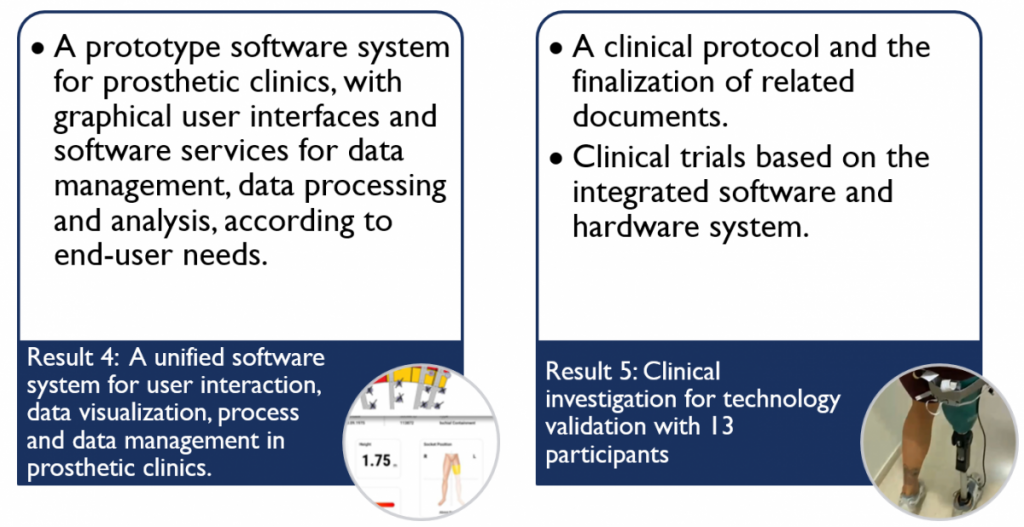Amputations pose significant challenges to individuals, profoundly affecting their quality of life. According to the World Health Organization, around 40 million amputees worldwide could benefit from improved prosthetics technology. Lower limb prosthetics are a key solution, with the prosthetic socket playing a vital role. This critical component links the prosthetic device to the residual limb, determining comfort, operational stability, and control. Designing and optimizing a prosthetic socket requires understanding the dynamic conditions inside the socket, a challenging task due to the complexity and limited observability of these conditions.
The SocketSense project has successfully responded to these challenges, aligning with the EU’s call for research on Flexible and Wearable Electronics (Topic: ICT-02-2018). By bringing together a wide array of technologies and scientific methods, we’ve created an intelligent IoT system tailored to individual patient needs. The system includes custom intra-socket sensor deployment, efficient data collection, advanced operational analysis, and personalized socket adaptation. The main outcomes of the project include:


-
- Development of multi-touch, multi-functional Quantum Technology Supersensor™ (QTSS™).
- Creation of a high-speed, low power electronic sensory system for operational data collection and analysis.
- Development of advanced algorithms for biomechanical assessment and socket adjustment.
- Launch of a unified software system for user interaction, data visualization, and management in prosthetic clinics.
- Completion of a clinical investigation with 13 participants to validate our technology.
Throughout the project, we identified 112 technical requirements, with 56 falling within the project’s prototype scope, and 104 within the minimum viable product (MVP) scope. The final system addressed all prototype scope requirements, with 39 fully met and 17 requiring additional work. Of the MVP requirements, 15 were fully met and 16 partially met.
Here’s a closer look at the project outcomes:
Outcome 1: Multi-touch, Multi-functional QTSS™ The project developed novel printed wearable sensors that measure dynamic intra-socket load conditions. The final output includes the ability to fabricate these sensors using environmentally-friendly materials and techniques, as well as custom assembly and deployment.
Outcome 2: High-speed, Low Power Electronic Sensory System The project developed an integrated electronic sensory system for collecting and analyzing operational data. This low-power, high-speed system uses a dual-core ESP32 System-on-Chip for real-time data treatment, and employs advanced algorithms to account for sensing and biomechanical uncertainties.
Outcome 3: Advanced Biomechanical Algorithms We developed algorithms to design and manufacture comfortable prosthetic sockets using wearable sensor technologies. The system includes features for sensor deployment, biomechanical assessment, data processing, and socket adjustment.
Outcome 4: Unified Software System for Prosthetic Clinics The project developed a user-friendly software system that includes data presentation and visualization, user interactions, data management, processing and analysis, and decision support.
Outcome 5: Clinical Investigation with Volunteer Participants The SocketSense system underwent clinical trials for validation. These trials, conducted with 14 volunteer participants, allowed for data collection and design refinement. Despite challenges posed by Covid-19, the trials verified the functionality and performance of the entire system, with participants expressing high satisfaction levels.
For further details about the open-access data summary of SocketSense, please follow the link: https://doi.org/10.5281/zenodo.7400478

Final Results
SocketSense was presented successfully at the Final review held in Brussels.

